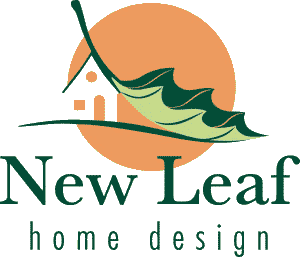Sustainability at New Leaf Home Design
Green Ideas for Every Home
Sustainability
Benefits to your family. There are a lot of reasons to choose green construction methods in the building of your new home, addition, or renovation. These best practices will make your home healthier and more comfortable as well as more sustainable, which is why New Leaf Home Design considers them central to our approach for every project. When you work with New Leaf and choose a contractor equally committed to building science, your home will have:
- Better indoor air quality: from attention to air sealing, controlled ventilation, and good air filtration.
-
Better comfort: from eliminating drafts, ample insulation, and good mechanical design.
-
Improved durability: from managing moisture- both bulk water and water vapor.
-
Lower utility bills: the result of right-sizing your house, orienting to take advantage of the sun, good air sealing, insulation, and careful mechanical design.
-
Greater resilience during power outages: because your home will maintain its temperature longer without mechanical heating or cooling.
Tried and true practices. Building green is no longer a cutting-edge approach used by just a few people on a handful of projects. We know how to build a more efficient, comfortable, healthy, durable home. The details and systems for sustainable construction have been implemented on thousands of homes, and researchers have verified their performance over decades of use. It is true that some older homes have lasted hundreds of years, but they have done so because of the large amounts of energy we pumped into their leaky construction, and their occupants had to suffer with drafts and dry air through the winter. New Leaf Home Design will help you create a twenty-first century home that will provide your family with both durability and comfort.
Long-term impacts. The decisions we make today determine what kind of world we will leave to our children and grandchildren. To prevent an irreversible change in the planet’s climate, humans must make drastic reductions to our CO2 emission within the next 15 to 20 years. If we make these changes in 25 or 30 years, the changes will come too late. Cities and states around the world have made a commitment to Net Zero Carbon by 2050, and organizations including the American Institute of Architects and the Structural Engineering Institute are encouraging their members to do the same. Since buildings and construction accounted for 39% of total U.S energy consumption in 2019, our built environment is an essential part of reaching a zero-carbon future. If you are planning a home construction project, it’s a great opportunity for you to have a positive impact!
Embodied Carbon. Our homes impact the amount of carbon in the atmosphere in two ways. One is the amount of carbon released into the atmosphere as we live in our houses. A more energy-efficient house will need less heating and cooling, and therefore will generate less operational carbon over its lifetime. The other impact is something we’ve only started to consider in the last couple of years: the embodied carbon of the building itself. All of the materials in our homes require energy to manufacture and transport, some more than others. A few, such as wood and cellulose, can actually store carbon for the life of the home. For a well-insulated efficient building, the embodied energy may amount to between 15% and 50% of the building’s total lifetime energy use. If you are building this year, all of the embodied energy gets burned this year, which means that all of the CO2 associated with that energy is going into the atmosphere this year. Because the next 15-20 years are so important for minimizing the impact of climate change, it is important to consider the short term impacts of construction as well as the long term ones. New Leaf will consider the embodied carbon impact of materials as well as the long term energy efficiency in the design of your home.
A Positive Energy Future

Every home can be part of our transition to a positive energy future, whether it’s a new home or more than 60 years old. Solar panels were just part of the change for the home above. We removed the gas meter and switched to a 100% renewable electric supplier. A heat pump water heater, air source heat pump, and induction cooktop keep the house comfortable with better indoor air quality than combustion appliances. And of course there is a charging station for electric vehicles in the garage! If your existing equipment is ready for replacement, it’s a great time to consider transitioning to electric.
If you work with New Leaf Home Design on a new home, I will design it for Zero Energy Ready certification. This program was designed by the Department of Energy to focus on the features that have the biggest impact on the comfort and energy efficiency of a home. You can learn more about the Zero Energy Ready homes here.
Even if you aren’t planning a major addition or renovation, you probably have one or two (or ten!) smaller home improvement projects on your to do list. Every one of these offers the opportunity to make your home more green, whether it’s painting a bedroom or buying a new hot water tank. And between now and 2032, the Inflation Reduction Act can provide you with tax credits for sustainable home improvements. Rewiring America has a great planning tool to help you decide which improvements are the best ones for your home. Pearl Certification is another great tool that can help you improve the performance of your home, find energy savings, and sell your home for more! Learning about your options and making a plan is key. Start making your plan today!
